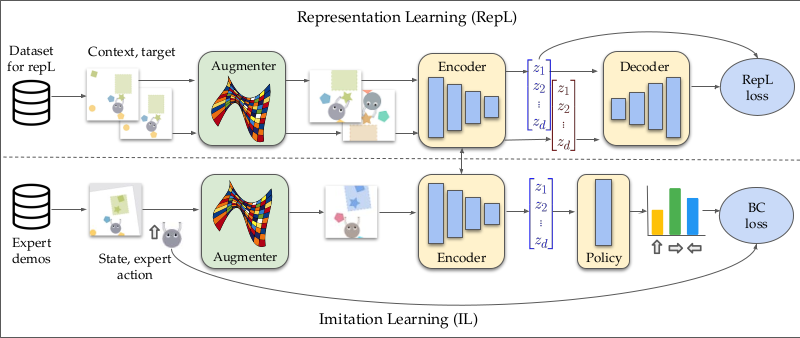Over the past handful of years, representation learning has exploded as a subfield, and, with it have come a plethora of new methods, each slightly different from the other.
Our Empirical Investigation of Representation Learning for Imitation (EIRLI) has two main goals:
- To create a modular algorithm definition system that allows researchers to easily pick and choose from a wide array of commonly used design axes
- To facilitate testing of representations within the context of sequential learning, particularly imitation learning and offline reinforcement learning
Do you want to…
- Reproduce our results? You can find scripts and instructions here to help reproduce our benchmark results.
- Design and experiment with a new representation learning algorithm using our modular components? You can find documentation on that here
- Use our algorithm definitions in a setting other than sequential learning? The base example here demonstrates this simplified use case
Otherwise, you can see our full ReadTheDocs documentation here.
This library was designed in a way that breaks down the definition of a representation learning algorithm into several key parts. The intention was that this system be flexible enough many commonly used algorithms can be defined through different combinations of these modular components.
The design relies on the central concept of a "context" and a "target". In very rough terms, all of our algorithms work by applying some transformation to the context, some transformation to the target, and then calculating a loss as a function of those two transformations. Sometimes an extra context object is passed in
Some examples are:
- In SimCLR, the context and target are the same image frame, and augmentation and then encoding is applied to both context and target. That learned representation is sent through a decoder, and then the context and target representations are pulled together with a contrastive loss.
- In TemporalCPC, the context is a frame at time t, and the target a frame at time t+k, and then, similarly to SimCLR above, augmentation is applied to the frame before it's put through an encoder, and the two resulting representations pulled together
- In a Variational Autoencoder, the context and target are the same image frame. An bottleneck encoder and then a reconstructive decoder are applied to the context, and this reconstructed context is compared to the target through a L2 pixel loss
- A Dynamics Prediction model can be seen as an conceptual combination of an autoencoder (which tries to predict the current full image frame) and TemporalCPC, which predicts future information based on current information. In the case of a Dynamics model, we predict a future frame (the target) given the current frame (context) and an action as extra context.
This abstraction isn't perfect, but we believe it is coherent enough to allow for a good number of shared mechanisms between algorithms, and flexible enough to support a wide variety of them.
The modular design mentioned above is facilitated through the use of a number of class interfaces, each of which handles a different component of the algorithm. By selecting different implementations of these shared interfaces, and creating a RepresentationLearner that takes them as arguments, and handles the base machinery of performing transformations.
- TargetPairConstructer - This component takes in a set of trajectories (assumed to be iterators of dicts containing 'obs' and optional 'acts', and 'dones' keys) and creates a dataset of (context, target, optional extra context) pairs that will be shuffled to form the training set.
- Augmenter - This component governs whether either or both of the context and target objects are augmented before being passed to the encoder. Note that this concept only meaningfully applies when the object being augmented is an image frame.
- Encoder - The encoder is responsible for taking in an image frame and producing a learned vector representation. It is optionally chained with a Decoder to produce the input to the loss function (which may be a reconstructed image in the case of VAE or Dynamics, or may be a projected version of the learned representation in the case of contrastive methods like SimCLR that use a projection head)
- Decoder - As mentioned above, the Decoder acts as a bridge between the representation in the form you want to use for transfer, and whatever input is required your loss function, which is often some transformation of that canonical representation.
- BatchExtender - This component is used for situations where you want to calculate loss on batch elements that are not part of the batch that went through your encoder and decoder on this step. This is centrally used for contrastive methods that use momentum, since in that case, you want to use elements from a cached store of previously-calculated representations as negatives in your contrastive loss
- LossCalculator - This component takes in the transformed context and transformed target and handles the loss calculation, along with any transformations that need to happen as a part of that calculation.
In addition to machinery for constructing algorithms, the repo contains a set of Sacred-based training scripts for testing different Representation Learning algorithms as either pretraining or joint training components within an imitation learning pipeline. These are likeliest to be a fit for your use case if you want to reproduce our results, or train models in similar settings

